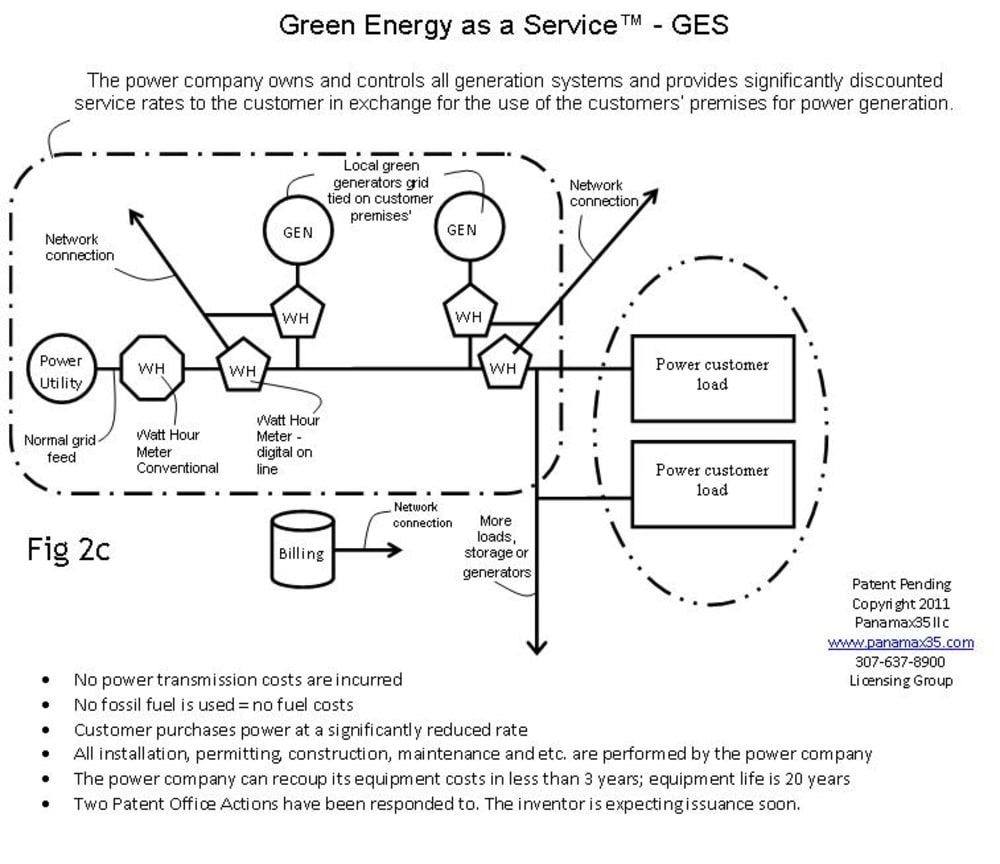This invention is the delivery of Green Energy as a Service (GES) which generates a positive cash flow for electric utilities while lowering the costs of electricity for residential, commercial and industrial customers.
GES consists of an innovative novel business method (patent pending) where renewable energy is generated by equipment that is installed on the customer’s premises where the equipment is owned by a utility, cooperative or third party. GES makes use of readily available technologies, legal frameworks, and existing infrastructure. GES is not limited to any technology and can encompass any kind of grid connected distributed renewable energy generator.
With this business method the utility finances, owns, installs, maintains and upgrades the equipment; performs all permitting, legal and administration needed. All of these functions become transparent to the customer and costs for transmission and fossil fuels are eliminated.
Customers without making any investment other than allowing the use of their premises, enjoy renewable energy at a significantly lower monthly cost than the retail price paid for non renewable or renewable electricity from other sources.
All other existing business models for renewable energy require subsidies in the form of tax credits, grants or non rentable investment with long amortization times. While GES does not require subsidies it does not exclude them; hence, further improving the bottom line.
GES helps utilities meet requirements from State Renewable Portfolio Standards in place in 30 states; and state and federal legislation and regulations for CO2 and other pollutants by increasing the use of renewable energy.
GES supplements the increasing need for new energy due to organic growth and retirement of coal and fossil fuel fired plants.
GES allows the standardizing of interconnection procedures, lowered installation and maintenance costs while also lowering costs for green technologies by performing mass deployments of best of class scalable and upgradable technologies.
With GES the utilities can remotely monitor the distributed generator/storage yield and aggregate capacity to optimize service and continually lower costs. As more smart grid technologies become available; and with utilities owning, managing, and controlling the distributed generators, utilities can also manage and optimize generation-storage-load at peak times as necessary. If the transmission grid fails GES could supplement power through the distributed generation network.
For the first five years of operations 15 States with retail cost of electricity over 12 cents kWh have been identified for initial launch. Of these markets the 2010 census indicates 40,186,630 occupied housing units and estimating 40% penetration the potential market would be 16,074,652 installations. Markets can be expanded to other states as more efficiencies are identified.
With such mass deployments GES allows for economies of scale and market leverage of best in class equipment. Further cost reductions are made through specialized mass production of OEM (wholesale) equipment and increased efficiencies from standardized installations and maintenance. Cost per installation of grid tied solar systems can be reduced to about 1/5 of the current retail pricing, with the equipment fully paid for in less than 3 years.
Like this entry?
-
About the Entrant
- Name:Eliot Case
- Type of entry:individual
- Software used for this entry:USPTO PAIR
- Patent status:pending

